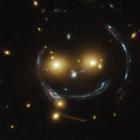The concept of gravitational lensing is that if an object is massive enough to bring together the light that passes on either side of it from a luminous body behind it, it acts as a kind of lens, focusing the light. The observer would see two images of the same body. If the luminous body is exactly behind the object, and the object is perfectly round, the observer would see a it as a ring around the object. Small deviations from this 'ideal' situation will produce duplicated images in a ring around the object. It is then a matter of interpretation and careful measurement to establish that they are indeed images of the same luminous body.
Measurement of gravitational effects due to globular clusters leads to the conclusion that the visible mass in the clusters is nowhere near enough to produce the observed gravitational lensing effects.
Mainstream science advances the observed gravitational lensing of distant globular clusters as evidence that visible matter is surrounded by massive haloes of dark matter. As discussed elsewhere, dark matter and its behaviour involve complex gaps.
QO explains the additional gravitational lensing effects in terms of the topology of the universe. This has an Occam score of 0200, relative to QO.
